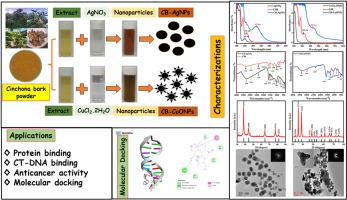Selectively activated plasma protein, DNA and cancer-cells by CB-Cu/Ag NPs
IF 4.9
3区 医学
Q1 PHARMACOLOGY & PHARMACY
Journal of Drug Delivery Science and Technology
Pub Date : 2025-09-25
DOI:10.1016/j.jddst.2025.107568
引用次数: 0
Abstract
Here, we reported the sustainable synthesis of metal nanoparticles (M = Cu and Ag) via eco-friendly, co-precipitation process using an aqueous extract of cinchona bark (CB) loaded with 0.005M CuCl2.2H2O and 0.01M AgNO3. Synthesize nanoparticles were characterized by different spectroscopic techniques. Their small particle sizes and distinct morphologies contribute to enhanced cellular uptake and improved interaction with biological targets, making them promising candidates for cancer treatment. The main objectives of this work are that the resulting nanoparticles were designed for passive targeted drug delivery through plasma protein (BSA/HSA) and CT-DNA binding. CB-CuONPs exhibited protein binding constants of 0.225 × 1011M−1 for BSA and 0.266 × 1011M−1 for HSA. Whereas CB-AgNPs showed higher affinity at 0.541 × 1011M−1 for BSA and 0.513 × 1011M−1 for HSA, and strongly interacted with CT-DNA (3.0669 × 1011M−1). Cytotoxicity studies revealed that CB-CuONPs showed potent cytotoxic activity, with IC50 concentrations of 65.8 μg for KB3 oral cancer KB3 cell line and 26.2 μg for AGS Colon cancer cell line, compared to CB-AgNPs (70.6 μg for KB3 and 54.6 μg for AGS cell lines). Combined cytotoxicity and biocompatibility findings suggest that CB-CuONPs may be more promising anticancer candidates than CB-AgNPs when used with proper dosage control. Additionally, molecular docking confirmed strong binding interactions of cinchona phytochemicals with BSA and CT-DNA, supporting their potential for passive targeted cancer therapy with minimal side effects toward eukaryotic cells.

CB-Cu/Ag NPs选择性激活血浆蛋白、DNA和癌细胞
本文报道了以金鸡纳树皮(CB)为原料,加入0.005M CuCl2.2H2O和0.01M AgNO3的水提物,通过共沉淀法可持续合成金属纳米颗粒(M = Cu和Ag)。采用不同的光谱技术对合成的纳米颗粒进行了表征。它们的小颗粒尺寸和独特的形态有助于增强细胞摄取和改善与生物靶点的相互作用,使它们成为癌症治疗的有希望的候选者。这项工作的主要目的是,所得到的纳米颗粒被设计用于通过血浆蛋白(BSA/HSA)和CT-DNA结合的被动靶向药物递送。CB-CuONPs对BSA和HSA的蛋白结合常数分别为0.225 × 1011M−1和0.266 × 1011M−1。而CB-AgNPs对BSA和HSA的亲和力分别为0.541 × 1011M−1和0.513 × 1011M−1,且与CT-DNA的相互作用较强(3.0669 × 1011M−1)。细胞毒性研究表明,CB-CuONPs对KB3口腔癌KB3细胞系和AGS结肠癌细胞系的IC50浓度分别为65.8 μg和26.2 μg,而CB-AgNPs对KB3细胞系和AGS细胞系的IC50浓度分别为70.6 μg和54.6 μg。综合细胞毒性和生物相容性研究结果表明,在适当的剂量控制下,CB-CuONPs可能比CB-AgNPs更有希望成为抗癌候选者。此外,分子对接证实了金鸡纳植物化学物质与BSA和CT-DNA的强结合相互作用,支持它们对真核细胞副作用最小的被动靶向癌症治疗的潜力。
本文章由计算机程序翻译,如有差异,请以英文原文为准。
求助全文
约1分钟内获得全文
求助全文
来源期刊
CiteScore
8.00
自引率
8.00%
发文量
879
审稿时长
94 days
期刊介绍:
The Journal of Drug Delivery Science and Technology is an international journal devoted to drug delivery and pharmaceutical technology. The journal covers all innovative aspects of all pharmaceutical dosage forms and the most advanced research on controlled release, bioavailability and drug absorption, nanomedicines, gene delivery, tissue engineering, etc. Hot topics, related to manufacturing processes and quality control, are also welcomed.

 求助内容:
求助内容: 应助结果提醒方式:
应助结果提醒方式:


